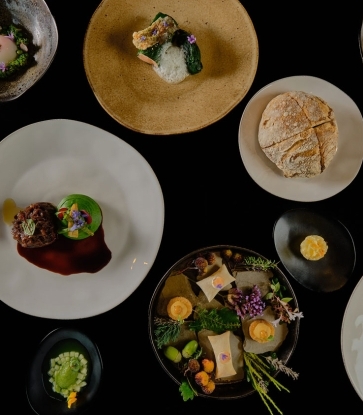Stateside chefs revere morel mushrooms so much that they've earned the nickname American truffles. Since the wild fungi in the morchella genus aren't generally cultivated, that makes them almost as rare and sought out with nearly equal fanaticism.
"In mid-March after the last snowflake falls, I'm always asking, 'Where are they? When can I get them?'" says Greg Lloyd, executive chef of Le Diplomate in Washington, D.C. "I don't care how much I have to spend."
The highly prized mushrooms with tubular honeycombed caps only come out in the spring—and only if the conditions are just right. Morels love damp, cool mornings and sunny afternoons that aren't too hot. The temperature needs to be over 50 degrees and series of lightly rainy days always helps get them popping. They favor growing under elm, ash, aspen, oak, poplar, cottonwood and apple trees, though not exclusively. And morels can be particularly prevalent the summer following a forest fire.
If all the elements and the environment are in accord, the 'shrooms can grow two and a half to four inches in a day. In the mid-Atlantic—where locals call them "merkels," or miracles, depending on the thickness of their Southern accent—they'll usually only come up for a few weeks in April and May. However, on the West Coast—where it's moister and the temperatures aren't scorching—the season lasts from late March into August.
Complicating matters is that morels are usually incredibly difficult to find. They range in color from black to brown to gray to blonde to white, and the mushrooms tend to blend right in with the leaves and undergrowth on the forest floor, hiding in plain sight. "You have to look extremely slowly," says Jonathan Till, executive chef of Evening Star Café in Alexandria, Virginia, who has been foraging for over a decade. "But when you spot one, they look like an alien brain coming out of the ground."
It should come as no surprise that morels are some of the most expensive wild mushrooms on the market. At the beginning of the season, when they're still scarce, a pound of morels can cost $60 or more.
The steep prices are worth it for chefs because the 'shrooms are so decadent and versatile. "A lot of people who don't like mushrooms like them," says Lloyd, "because they've got this flavor that's full of umami—earthy and nutty."
"They're meaty, but light—like veal," adds Till.
Virginians have a tradition of battering the mushrooms, frying them and adding a little beef stock to make thick gravy that goes perfectly with venison or a steak. Or they sauté them and add them to scrambled eggs.
Till and Lloyd agree that keeping the preparations simple is key, allowing the morels to really shine. Currently, Till is using them to stuff uszka, traditional Eastern European dumplings that look similar to Italian tortellini. Sometimes he utilizes the mushrooms as a casing. "I love filling them with cheese or forcemeat, so it's like an all-natural sausage," he says.
Meanwhile, Lloyd is serving sautéed morels with pan-roasted salmon, and veal escalope accompanied by morels and ramps as specials.
Both chefs generally source morels from large-scale wild food companies (Earthy Delights and Mikuni Wild Harvest are two well-known options), farmers markets or local foragers, because personally going out for them is time consuming and unreliable. "If you got a pound of morels, you had an extremely good day," says Till.






















